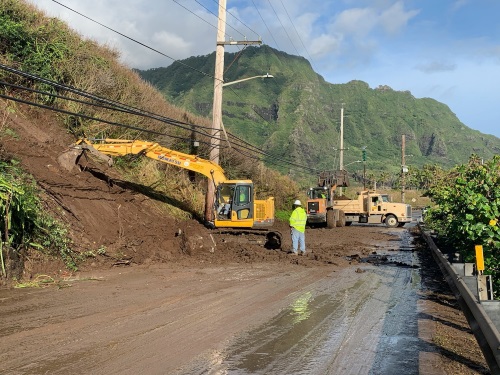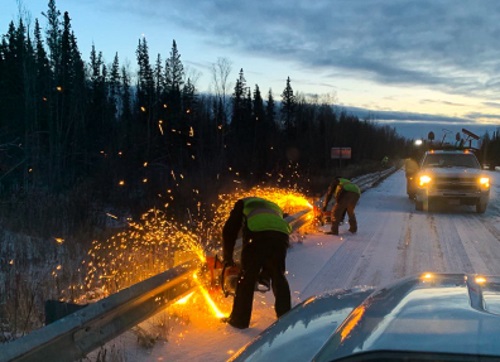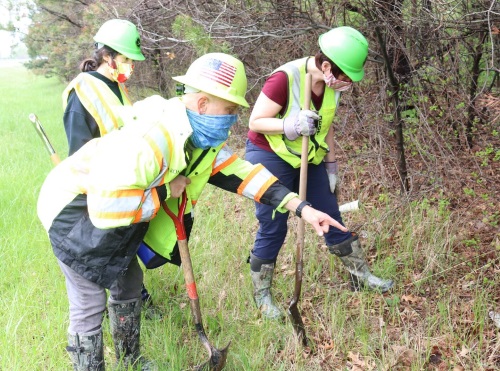A panel of state department of transportation executives and managers, as well as a team leader from the Federal Highway Administration, recently shared their insights on infrastructure resilience via a peer exchange during the American Association of State Highway and Transportation Officials 2021 virtual spring meeting.
[Above photo by the Hawaii DOT]
“We are seeing events such as wildfires, flooding, and hurricanes becoming more extreme and occurring more often,” explained Edwin Sniffen, deputy director of highways for the Hawaii Department of Transportation. “We are also seeing more ‘man-made’ issues, too, such as cybersecurity, terrorist attacks, and the like. So it is super important to make our [infrastructure] systems more resilient.”

Sniffen – who also serves as chair of the American Association of State Highway and Transportation Officials Committee on Transportation System Security and Resilience – added that “emergency response” is becoming a more crucial component of resiliency efforts at the state DOT level. “That’s one reason why we want to try and make FHWA ER [emergency relief] funding more consistent across the nation,” he explained. “Everyone is looking towards how to make things better.”
[Sniffen expanded further on Hawaii DOT’s resiliency philosophy during testimony May 13 before the Senate Committee on Appropriations.]
Michael Culp – who is FHWA’s team leader for sustainable transportation and resilience – noted during the exchange that his agency is “really focused on integrating resilience across the board. I would expect in the future to see more [resilience] policies coming out on all of these fronts; not just for state DOTs but for FHWA and the U.S. Department of Transportation, too.”

That includes more “technical guidance type work” and pilot projects where resiliency is concerned, he added.
“We’re seeing a ramped up focus on climate/extreme weather and how it impacts the highway system,” Culp noted, emphasizing that there is “a lot of interest” on Capitol Hill in seeing that the federal surface program integrate resilience within the nation’s transportation system.
“Resilience will also definitely have a lot of presence in federal [infrastructure] legislation, whatever it ends up looking like,” he added.
Elizabeth ‘Lizzie’ Kemp, head of the Colorado Department of Transportation’s resiliency program, noted that her agency “started down the path of resiliency planning” eight years ago in response to major flooding that occurred in 2013.

Since then, the Colorado DOT has developed a tool to calculate infrastructure risk while assessing the potential benefits of resiliency investments. “We’ve started looking at this from planning perspective – deploying resilient designs in high risk areas where benefit costs support it,” she explained.
“It is not an easy process to develop such tools as the data are not always there. We have spent the last three or so years developing a robust tool kit to improve our resiliency decision-making in a day-to-day way,” Kemp added. “That is the key: getting better data for our tool kit and then integrating its findings into our day-to-day decision-making process.”
Yet Jennifer Carver – statewide community planning coordinator for the Florida Department of Transportation – cautioned that incorporating resilience into infrastructure planning “is not a quick thing.” It also involves all of the infrastructure-related processes within a state DOT: long-range planning, construction and design, plus maintenance.
“Over last few years we set up a framework on how to ‘name’ resilience and point to where we are incorporating it in our infrastructure efforts,” she said. “That’s helped energize our agency around resilience and make it part of what we do. It makes every project into a resilience project.”

Gregg Brunner, director of bureau of field services for the Michigan Department of Transportation, said efforts like Florida DOT’s are vital to “bring more folks to the table” within a state DOT “from an educational standpoint in order to create awareness of the resiliency terminology.”
Developing agency-wide risk assessment and management process is the next step, he said. “It’s about breaking down risk management into two parts – agency risk, or how it impacts Michigan DOT as a whole, and then project-level risk.”
Brunner added that “agency level threats” include things that affect the department’s labor force, technology, and financial health. Project level risks, by contrast, include things like extreme weather events. “From there we develop a risk matrix: Examining likelihood of things like flooding or cyberattacks occurring in different areas around Michigan.”

Geography makes a big difference, too, he noted. For example, while six inches of snow in the Upper Peninsula region of the state would be a non-event – “business would carry on as usual,” Brunner said – six inches in Detroit would shut down the city.
“Developing a risk assessment matrix is what helps us pinpoint locales with highest risk factors,” he said.
Chris Engelbrecht, assistant to the chief safety and operations officer at the Missouri Department of Transportation, stressed that planning ahead for disaster is crucial – especially when trying to build in more infrastructure resiliency.
“The hardest time to incorporate resilience is in the disaster recovery phase – that is when we’re stressed with reopening closed roads as fast as possible,” he said. “Thus it is a struggle to bring resilience into the repair process.”
That’s why predictive tools are so important when it comes to planning resiliency improvements. “Looking at historical data does not always give us the full risk picture either,” Engelbrecht noted. “We need to look to the horizon, to examine changing weather patterns so we obtain ‘leading indicators’ before extreme events happen.”

The Minnesota Department of Transportation is already doing that to a degree, noted Tim Sexton, the agency’s assistant commissioner for sustainability and health.
“Right now Minnesota is forecasted to be the number one or two state in the nation affected by climate change; it’ll be getting warmer and wetter for us,” he said. “So the first risk we face is more flooding – and that directly impacts things like slope failures along our highway and railroad networks.
By contrast, warmer winters create more freeze and thaw cycles, which affect pavement durability. “Climate change shines a spotlight on inequities in all states,” Sexton noted. “That’s why we are adjusting resilience to be part of our long-range policy and infrastructure investment plans.”



